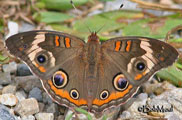Native Plants
Search for native plants by scientific name, common name or family. If you are not sure what you are looking for, try the Combination Search or our Recommended Species lists.
Ruellia drummondiana
Ruellia drummondiana (Nees) A. Gray
Drummond's Ruellia, Drummond's Wild Petunia
Acanthaceae (Acanthus Family)
Synonym(s): Dipteracanthus drummondianus
USDA Symbol: rudr
USDA Native Status: L48 (N)
The species name of this plant is named for Thomas Drummond, (ca. 1790-1835), naturalist, born in Scotland, around 1790. In 1830 he made a trip to America to collect specimens from the western and southern United States. In March, 1833, he arrived at Velasco, Texas to begin his collecting work in that area. He spent twenty-one months working the area between Galveston Island and the Edwards Plateau, especially along the Brazos, Colorado, and Guadalupe rivers. His collections were the first made in Texas that were extensively distributed among the museums and scientific institutions of the world. He collected 750 species of plants and 150 specimens of birds. Drummond had hoped to make a complete botanical survey of Texas, but he died in Havana, Cuba, in 1835, while making a collecting tour of that island.
Plant Characteristics
Duration: PerennialHabit: Herb
Root Type: Fibrous
Leaf Retention: Deciduous
Leaf Complexity: Simple
Leaf Shape: Ovate
Leaf Venation: Pinnate
Leaf Pubescence: Puberulent
Leaf Margin: Undulate
Leaf Apex: Obtuse
Leaf Base: Cuneate
Breeding System: Flowers Bisexual
Fruit Type: Capsule
Size Notes: Up to about 3 feet tall.
Leaf: Dark-green above.
Flower: Flowers 42 mm long.
Fruit: 1 cm
Bloom Information
Bloom Color: PurpleBloom Time: Jun , Jul , Aug , Sep , Oct , Nov
Distribution
USA: TXNative Habitat: Woodlands' edge, Opening, Prairie, Plains, Meadows, Pastures, Savannas
Growing Conditions
Water Use: LowLight Requirement: Part Shade , Shade
Soil Moisture: Dry
Soil Description: Rocky soils.
Conditions Comments: Drummond's wild petunia grows handsome lavender flowers throughout the summer. Cut back old bloom stalks in the winter. It has taller flowers and is taller than Wild petunia.
Benefit
Use Ornamental: Blooms ornamental, Perennial gardenConspicuous Flowers: yes
Attracts: Butterflies
Larval Host: Common buckeye
Nectar Source: yes
Deer Resistant: Minimal
Butterflies and Moths of North America (BAMONA)
|
Common Buckeye (Junonia coenia)  Larval Host |
Propagation
Propagation Material: Root DivisionMaintenance: Maintain moist soil, Fertilize in spring with rose food
From the National Organizations Directory
According to the species list provided by Affiliate Organizations, this plant is on display at the following locations:Lady Bird Johnson Wildflower Center - Austin, TX
Brackenridge Field Laboratory - Austin, TX
Bibliography
Bibref 1186 - Field Guide to Moths of Eastern North America (2005) Covell, C.V., Jr.Bibref 1185 - Field Guide to Western Butterflies (Peterson Field Guides) (1999) Opler, P.A. and A.B. Wright
Bibref 841 - Native Alternatives to Invasive Plants (2006) Burrell, C. C.
Search More Titles in Bibliography
Web Reference
Webref 23 - Southwest Environmental Information Network (2009) SEINet - Arizona ChapterAdditional resources
USDA: Find Ruellia drummondiana in USDA PlantsFNA: Find Ruellia drummondiana in the Flora of North America (if available)
Google: Search Google for Ruellia drummondiana
Metadata
Record Modified: 2023-02-24Research By: TWC Staff, JSC